英语修辞的翻译_unit_20
- 格式:ppt
- 大小:756.00 KB
- 文档页数:45
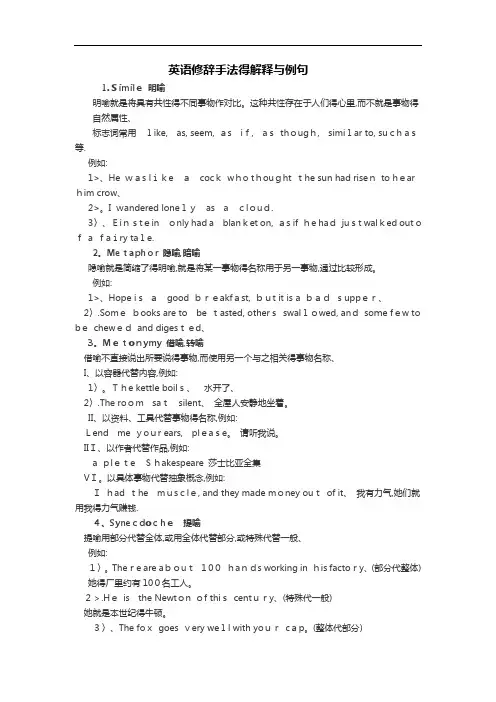
英语修辞手法得解释与例句1.Simile明喻明喻就是将具有共性得不同事物作对比。
这种共性存在于人们得心里,而不就是事物得自然属性、标志词常用like, as, seem, as if, asthough, similar to, such as等.例如:1>、He was like acockwho thought the sun had risento hear him crow、2>。
I wandered lonelyas a cloud.3〉、Einstein only had a blanket on, as if he hadjust walked out o fa fairy tale.2。
Metaphor 隐喻,暗喻隐喻就是简缩了得明喻,就是将某一事物得名称用于另一事物,通过比较形成。
例如:1>、Hope isagood breakfast, but it is a badsupper、2〉.Somebooks are to be tasted, othersswallowed, andsome few to bechewedand digested、3。
Metonymy 借喻,转喻借喻不直接说出所要说得事物,而使用另一个与之相关得事物名称、I、以容器代替内容,例如:1〉。
The kettle boils、水开了、2〉.The room satsilent、全屋人安静地坐着。
II、以资料、工具代替事物得名称,例如:Lend me your ears, please。
请听我说。
III、以作者代替作品,例如:a plete Shakespeare 莎士比亚全集VI。
以具体事物代替抽象概念,例如:Ihad the muscle, and they made money outof it、我有力气,她们就用我得力气赚钱.4、Synecdoche提喻提喻用部分代替全体,或用全体代替部分,或特殊代替一般、例如:1〉。
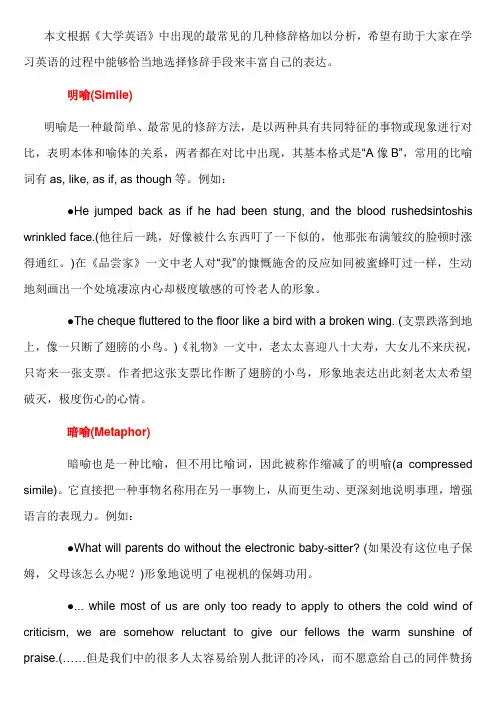
本文根据《大学英语》中出现的最常见的几种修辞格加以分析,希望有助于大家在学习英语的过程中能够恰当地选择修辞手段来丰富自己的表达。
明喻(Simile)明喻是一种最简单、最常见的修辞方法,是以两种具有共同特征的事物或现象进行对比,表明本体和喻体的关系,两者都在对比中出现,其基本格式是“A像B”,常用的比喻词有as, like, as if, as though等。
例如:●He jumped back as if he had been stung, and the blood rushedsint oshis wrinkled face.(他往后一跳,好像被什么东西叮了一下似的,他那张布满皱纹的脸顿时涨得通红。
)在《品尝家》一文中老人对“我”的慷慨施舍的反应如同被蜜蜂叮过一样,生动地刻画出一个处境凄凉内心却极度敏感的可怜老人的形象。
●The cheque fluttered to the floor like a bird with a broken wing. (支票跌落到地上,像一只断了翅膀的小鸟。
)《礼物》一文中,老太太喜迎八十大寿,大女儿不来庆祝,只寄来一张支票。
作者把这张支票比作断了翅膀的小鸟,形象地表达出此刻老太太希望破灭,极度伤心的心情。
暗喻(Metaphor)暗喻也是一种比喻,但不用比喻词,因此被称作缩减了的明喻(a compressed simile)。
它直接把一种事物名称用在另一事物上,从而更生动、更深刻地说明事理,增强语言的表现力。
例如:●What will parents do without the electronic baby-sitter? (如果没有这位电子保姆,父母该怎么办呢?)形象地说明了电视机的保姆功用。
●... while most of us are only too ready to apply to others the cold wind of criticism, we are somehow reluctant to give our fellows the warm sunshine of praise.(……但是我们中的很多人太容易给别人批评的冷风,而不愿意给自己的同伴赞扬的阳光。
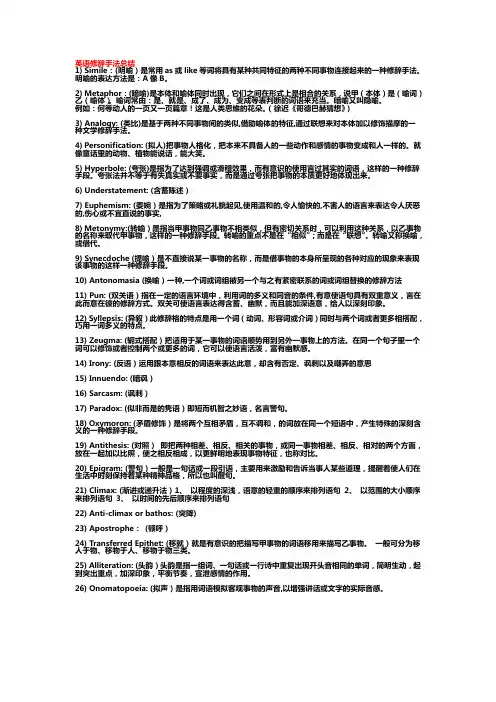
英语修辞手法总结1) Simile:(明喻)是常用as或like等词将具有某种共同特征的两种不同事物连接起来的一种修辞手法。
明喻的表达方法是:A像B。
2) Metaphor:(暗喻)是本体和喻体同时出现,它们之间在形式上是相合的关系,说甲(本体)是(喻词)乙(喻体)。
喻词常由:是、就是、成了、成为、变成等表判断的词语来充当。
暗喻又叫隐喻。
例如:何等动人的一页又一页篇章!这是人类思维的花朵。
(徐迟《哥德巴赫猜想》)3) Analogy: (类比)是基于两种不同事物间的类似,借助喻体的特征,通过联想来对本体加以修饰描摩的一种文学修辞手法。
4) Personification: (拟人)把事物人格化,把本来不具备人的一些动作和感情的事物变成和人一样的。
就像童话里的动物、植物能说话,能大笑。
5) Hyperbole: (夸张)是指为了达到强调或滑稽效果,而有意识的使用言过其实的词语,这样的一种修辞手段。
夸张法并不等于有失真实或不要事实,而是通过夸张把事物的本质更好地体现出来。
6) Understatement: (含蓄陈述)7) Euphemism: (委婉)是指为了策略或礼貌起见,使用温和的,令人愉快的,不害人的语言来表达令人厌恶的,伤心或不宜直说的事实,8) Metonymy:(转喻)是指当甲事物同乙事物不相类似,但有密切关系时,可以利用这种关系,以乙事物的名称来取代甲事物,这样的一种修辞手段。
转喻的重点不是在“相似”;而是在“联想”。
转喻又称换喻,或借代。
9) Synecdoche (提喻)是不直接说某一事物的名称,而是借事物的本身所呈现的各种对应的现象来表现该事物的这样一种修辞手段。
10) Antonomasia (换喻)一种,一个词或词组被另一个与之有紧密联系的词或词组替换的修辞方法11) Pun: (双关语)指在一定的语言环境中,利用词的多义和同音的条件,有意使语句具有双重意义,言在此而意在彼的修辞方式。
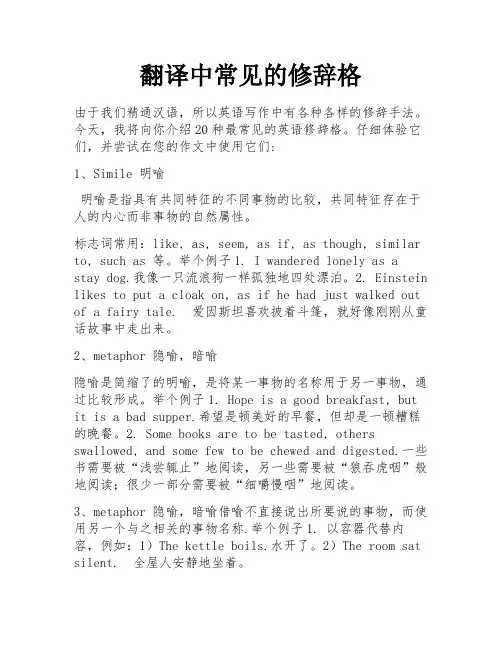
翻译中常见的修辞格由于我们精通汉语,所以英语写作中有各种各样的修辞手法。
今天,我将向你介绍20种最常见的英语修辞格。
仔细体验它们,并尝试在您的作文中使用它们:1、Simile 明喻明喻是指具有共同特征的不同事物的比较,共同特征存在于人的内心而非事物的自然属性。
标志词常用:like, as, seem, as if, as though, similar to, such as 等。
举个例子1. I wandered lonely as astay dog.我像一只流浪狗一样孤独地四处漂泊。
2. Einstein likes to put a cloak on, as if he had just walked out of a fairy tale. 爱因斯坦喜欢披着斗篷,就好像刚刚从童话故事中走出来。
2、metaphor 隐喻,暗喻隐喻是简缩了的明喻,是将某一事物的名称用于另一事物,通过比较形成。
举个例子1. Hope is a good breakfast, but it is a bad supper.希望是顿美好的早餐,但却是一顿糟糕的晚餐。
2. Some books are to be tasted, others swallowed, and some few to be chewed and digested.一些书需要被“浅尝辄止”地阅读,另一些需要被“狼吞虎咽”般地阅读;很少一部分需要被“细嚼慢咽”地阅读。
3、metaphor 隐喻,暗喻借喻不直接说出所要说的事物,而使用另一个与之相关的事物名称.举个例子1. 以容器代替内容,例如:1)The kettle boils.水开了。
2)The room sat silent. 全屋人安静地坐着。
2. 以资料、工具代替事物的名称,例如:Lend me your ears, please. 请听我说。
3. 以代替作品,例如:a plete Shakespeare 莎士比亚全集4. 以具体事物代替抽象概念,例如:I had the muscle, and they made money out of it. 我有力气,他们就用我的力气赚钱。
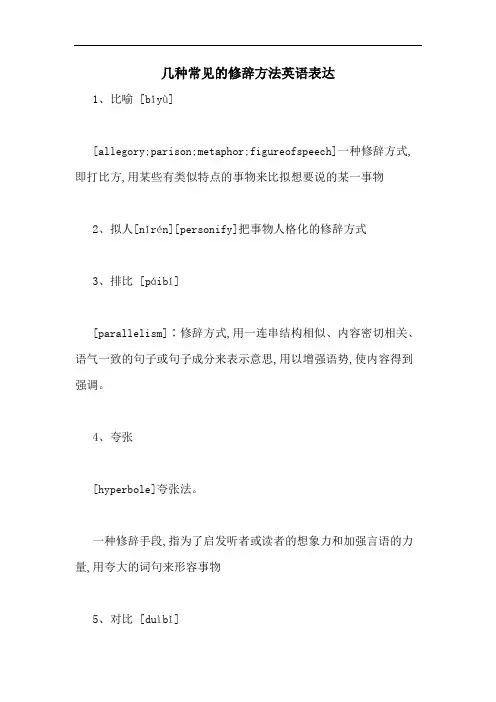
几种常见的修辞方法英语表达
1、比喻 [bǐyù]
[allegory;parison;metaphor;figureofspeech]一种修辞方式,即打比方,用某些有类似特点的事物来比拟想要说的某一事物
2、拟人[nǐrén][personify]把事物人格化的修辞方式
3、排比 [páibǐ]
[parallelism]∶修辞方式,用一连串结构相似、内容密切相关、语气一致的句子或句子成分来表示意思,用以增强语势,使内容得到强调。
4、夸张
[hyperbole]夸张法。
一种修辞手段,指为了启发听者或读者的想象力和加强言语的力量,用夸大的词句来形容事物
5、对比 [duìbǐ]
[contrast;balance]∶[两种事物或一事物的两个方面]相对比较
6、夸张[kuāzhāng]
[hyperbole]夸张法。
一种修辞手段,指为了启发听者或读者的想象力和加强言语的力量,用夸大的词句来形容事物
写作手法及作用
(1)拟人手法:赋予事物以人的性格、思想、感情和动作,使物人格化,从而达到形象生动的效果。
(2)比喻手法形象生动、简洁凝练地描写:事物、讲解道理。
(3)夸张手法:突出事物的特征,揭;示本质,给读者以鲜明而强烈的印象
(4)象征手法;把特定的意义寄托在所描写拘事物上,表达了……的情感,增强了文章的表现力。
(5)对比手法:通过比较,突出事物的特点,更好地表现文章的主题。
(9)衬托手法(侧面烘托):以次要的人或事物衬托主要的人或事物,突出主要的人或事物的特点、性格、思想、感情等。
模板,内容仅供参考。
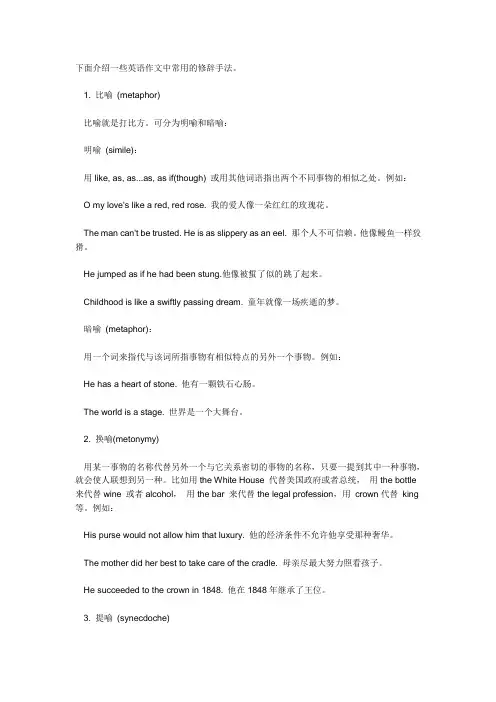
下面介绍一些英语作文中常用的修辞手法。
1. 比喻(metaphor)比喻就是打比方。
可分为明喻和暗喻:明喻(simile):用like, as, as...as, as if(though) 或用其他词语指出两个不同事物的相似之处。
例如:O my love's like a red, red rose. 我的爱人像一朵红红的玫瑰花。
The man can't be trusted. He is as slippery as an eel. 那个人不可信赖。
他像鳗鱼一样狡猾。
He jumped as if he had been stung.他像被蜇了似的跳了起来。
Childhood is like a swiftly passing dream. 童年就像一场疾逝的梦。
暗喻(metaphor):用一个词来指代与该词所指事物有相似特点的另外一个事物。
例如:He has a heart of stone. 他有一颗铁石心肠。
The world is a stage. 世界是一个大舞台。
2. 换喻(metonymy)用某一事物的名称代替另外一个与它关系密切的事物的名称,只要一提到其中一种事物,就会使人联想到另一种。
比如用the White House 代替美国政府或者总统,用the bottle 来代替wine 或者alcohol,用the bar 来代替the legal profession,用crown代替king 等。
例如:His purse would not allow him that luxury. 他的经济条件不允许他享受那种奢华。
The mother did her best to take care of the cradle. 母亲尽最大努力照看孩子。
He succeeded to the crown in 1848. 他在1848年继承了王位。
3. 提喻(synecdoche)指用部分代表整体或者用整体代表部分,以特殊代表一般或者用一般代表特殊。
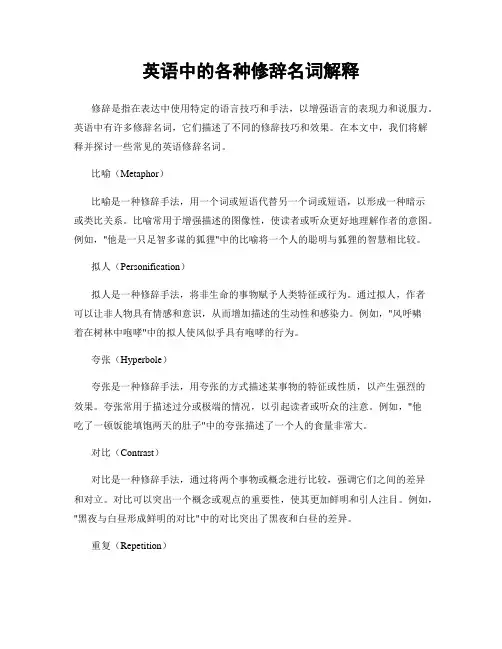
英语中的各种修辞名词解释修辞是指在表达中使用特定的语言技巧和手法,以增强语言的表现力和说服力。
英语中有许多修辞名词,它们描述了不同的修辞技巧和效果。
在本文中,我们将解释并探讨一些常见的英语修辞名词。
比喻(Metaphor)比喻是一种修辞手法,用一个词或短语代替另一个词或短语,以形成一种暗示或类比关系。
比喻常用于增强描述的图像性,使读者或听众更好地理解作者的意图。
例如,"他是一只足智多谋的狐狸"中的比喻将一个人的聪明与狐狸的智慧相比较。
拟人(Personification)拟人是一种修辞手法,将非生命的事物赋予人类特征或行为。
通过拟人,作者可以让非人物具有情感和意识,从而增加描述的生动性和感染力。
例如,"风呼啸着在树林中咆哮"中的拟人使风似乎具有咆哮的行为。
夸张(Hyperbole)夸张是一种修辞手法,用夸张的方式描述某事物的特征或性质,以产生强烈的效果。
夸张常用于描述过分或极端的情况,以引起读者或听众的注意。
例如,"他吃了一顿饭能填饱两天的肚子"中的夸张描述了一个人的食量非常大。
对比(Contrast)对比是一种修辞手法,通过将两个事物或概念进行比较,强调它们之间的差异和对立。
对比可以突出一个概念或观点的重要性,使其更加鲜明和引人注目。
例如,"黑夜与白昼形成鲜明的对比"中的对比突出了黑夜和白昼的差异。
重复(Repetition)重复是一种修辞手法,通过多次使用相同的词语、短语或句子来强调一个观点或增加句子的节奏感。
重复可以使文本更具吸引力和重要性,激发读者或听众的情感共鸣。
例如,"我可以,我一定可以"中的重复加强了自信和决心的表达。
反问(Rhetorical Question)反问是一种修辞手法,通过提出一个问题,但不期望得到一个明确的回答,强调自己的观点或引起读者或听众的思考。
反问常用于辩论或演讲中,以增加说服力和互动性。
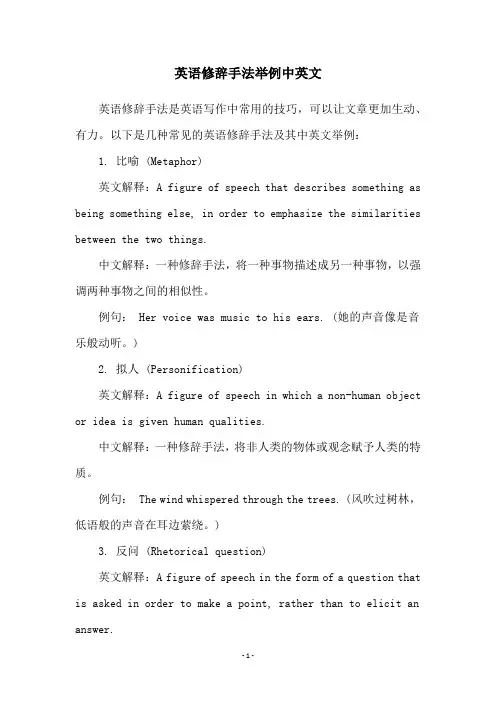
英语修辞手法举例中英文英语修辞手法是英语写作中常用的技巧,可以让文章更加生动、有力。
以下是几种常见的英语修辞手法及其中英文举例:1. 比喻 (Metaphor)英文解释:A figure of speech that describes something as being something else, in order to emphasize the similarities between the two things.中文解释:一种修辞手法,将一种事物描述成另一种事物,以强调两种事物之间的相似性。
例句: Her voice was music to his ears. (她的声音像是音乐般动听。
)2. 拟人 (Personification)英文解释:A figure of speech in which a non-human object or idea is given human qualities.中文解释:一种修辞手法,将非人类的物体或观念赋予人类的特质。
例句: The wind whispered through the trees. (风吹过树林,低语般的声音在耳边萦绕。
)3. 反问 (Rhetorical question)英文解释:A figure of speech in the form of a question that is asked in order to make a point, rather than to elicit an answer.中文解释:一种修辞手法,以问句的形式表达观点,而不是期望得到回答。
例句: Would you jump off a bridge just because your friends did? (你会因为朋友跳桥而跟随吗?)4. 排比 (Parallelism)英文解释:The use of similar grammatical structures, phrases or words to create a rhythmic and balanced effect.中文解释:一种修辞手法,使用相似的语法结构、短语或单词,以创造节奏感和平衡效果。
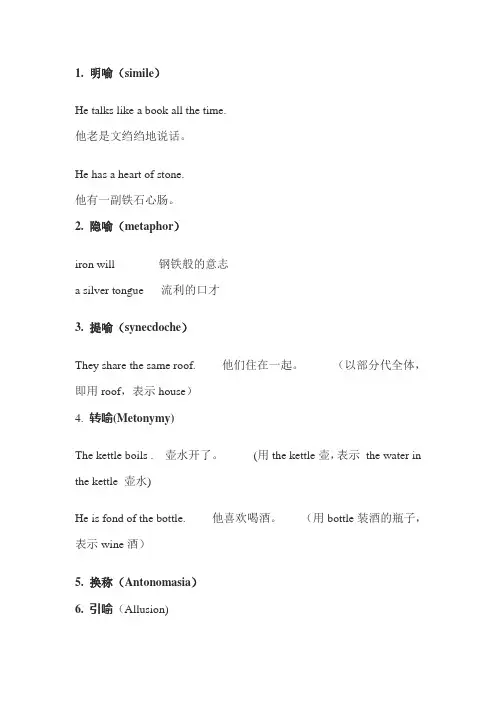
1. 明喻(simile)He talks like a book all the time.他老是文绉绉地说话。
He has a heart of stone.他有一副铁石心肠。
2. 隐喻(metaphor)iron will 钢铁般的意志a silver tongue 流利的口才3. 提喻(synecdoche)They share the same roof. 他们住在一起。
(以部分代全体,即用roof,表示house)4. 转喻(Metonymy)The kettle boils . 壶水开了。
(用the kettle壶,表示the water in the kettle 壶水)He is fond of the bottle. 他喜欢喝酒。
(用bottle装酒的瓶子,表示wine酒)5. 换称(Antonomasia)6. 引喻(Allusion)Greek gift.黄鼠狼给鸡拜年。
The apple of discord.不和之因。
7. 对照或对比(antithesis)Take little, give much.少索取,多奉献。
Pride hurts, modesty benefits. 满招损,谦受益。
All for one, one for all.人人为我,我为人人。
8. 平行(Parallelism)No one can be perfectly free till all are free; no one can be perfectly moral till all are moral; no one can be perfectly happy till all are happy.9. 拟人(Personification)The flowers nodded in the breeze.花儿在微风中点头。
10. 矛盾修饰法oxymoronin a deafening silence 震耳欲聋的沉默a mournful optimist 悲伤的乐观11. 夸张(hyperbole)I ‘d give the world to see you.只要能见到你,我愿意付出任何代价。
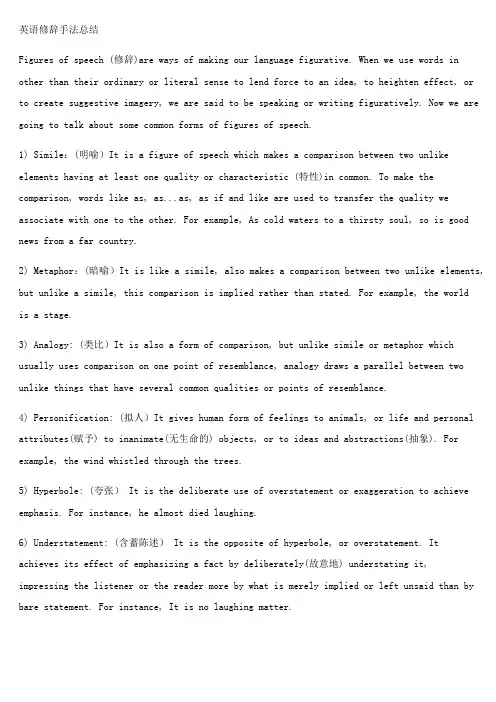
英语修辞手法总结Figures of speech (修辞)are ways of making our language figurative. When we use words in other than their ordinary or literal sense to lend force to an idea, to heighten effect, orto create suggestive imagery, we are said to be speaking or writing figuratively. Now we are going to talk about some common forms of figures of speech.1) Simile:(明喻)It is a figure of speech which makes a comparison between two unlike elements having at least one quality or characteristic (特性)in common. To make the comparison, words like as, as...as, as if and like are used to transfer the quality we associate with one to the other. For example, As cold waters to a thirsty soul, so is good news from a far country.2) Metaphor:(暗喻)It is like a simile, also makes a comparison between two unlike elements, but unlike a simile, this comparison is implied rather than stated. For example, the worldis a stage.3) Analogy: (类比)It is also a form of comparison, but unlike simile or metaphor which usually uses comparison on one point of resemblance, analogy draws a parallel between two unlike things that have several common qualities or points of resemblance.4) Personification: (拟人)It gives human form of feelings to animals, or life and personal attributes(赋予) to inanimate(无生命的) objects, or to ideas and abstractions(抽象). For example, the wind whistled through the trees.5) Hyperbole: (夸张) It is the deliberate use of overstatement or exaggeration to achieve emphasis. For instance, he almost died laughing.6) Understatement: (含蓄陈述) It is the opposite of hyperbole, or overstatement. Itachieves its effect of emphasizing a fact by deliberately(故意地) understating it,impressing the listener or the reader more by what is merely implied or left unsaid than by bare statement. For instance, It is no laughing matter.7) Euphemism: (委婉) It is the substitution of an agreeable or inoffensive(无冒犯) expression for one that may offend or suggest something unpleasant. For instance, we refer to "die" as " pass away".8) Metonymy (转喻)It is a figure of speech that has to do with the substitution of the mane of one thing for that of another. For instance, the pen (words) is mightier than the sword (forces).9) Synecdoche (提喻) It is involves the substitution of the part for the whole, or thewhole for the part. For instance, they say there's bread and work for all. She was dressedin silks.10) Antonomasia (换喻)It has also to do with substitution. It is not often mentioned now, though it is still in frequent use. For example, Solomon for a wise man. Daniel for a wise and fair judge. Judas for a traitor.11) Pun: (双关语) It is a play on words, or rather a play on the form and meaning of words. For instance, a cannon-ball took off his legs, so he laid down his arms. (Here "arms" has two meanings: a person's body; weapons carried by a soldier.)12) Syllepsis: (一语双叙) It has two connotations.In the first case, it is a figure by which a word, or a particular form or inflection of a word, refers to two or more words in the same sentence, while properly applying to or agreeing with only on of them in grammar or syntax(句法). For example, He addressed you and me, and desired us to follow him. (Here us is used to refer to you and me.)In the second case, it a word may refer to two or more words in the same sentence. For example, while he was fighting , and losing limb and mind, and dying, others stayed behind to pursue education and career. (Here to losing one's limbs in literal; to lose one's mindis figurative, and means to go mad.)13) Zeugma: (轭式搭配) It is a single word which is made to modify or to govern two or more words in the same sentence, wither properly applying in sense to only one of them, orapplying to them in different senses. For example, The sun shall not burn you by day, nor the moon by night. (Here noon is not strong enough to burn)14) Irony: (反语) It is a figure of speech that achieves emphasis by saying the opposite of what is meant, the intended meaning of the words being the opposite of their usual sense. For instance, we are lucky, what you said makes me feel real good.15) Innuendo: (暗讽) It is a mild form of irony, hinting in a rather roundabout (曲折)way at something disparaging(不一致) or uncomplimentary(不赞美) to the person or subject mentioned. For example, the weatherman said it would be worm. He must take his readings in a bathroom.16) Sarcasm: (讽刺) It Sarcasm is a strong form of irony. It attacks in a taunting and bitter manner, and its aim is to disparage, ridicule and wound the feelings of the subject attacked. For example, laws are like cobwebs, which may catch small flies, but let wasps break through.17) Paradox: (似非而是的隽语) It is a figure of speech consisting of a statement or proposition which on the face of it seems self-contradictory, absurd or contrary to established fact or practice, but which on further thinking and study may prove to be true, well-founded, and even to contain a succinct point. For example more haste, less speed.18) Oxymoron: (矛盾修饰) It is a compressed paradox, formed by the conjoining(结合) of two contrasting, contradictory or incongruous(不协调) terms as in bitter-sweet memories, orderly chaos(混乱) and proud humility(侮辱).19) Antithesis: (对照) It is the deliberate arrangement of contrasting words or ideas in balanced structural forms to achieve emphasis. For example, speech is silver; silence is golden.20) Epigram: (警句) It states a simple truth pithily(有利地) and pungently(强烈地). It is usually terse and arouses interest and surprise by its deep insight into certain aspects of human behavior or feeling. For instance, Few, save the poor, feel for the poor.21) Climax: (渐进) It is derived from the Greek word for "ladder" and implies the progression of thought at a uniform or almost uniform rate of significance or intensity,like the steps of a ladder ascending evenly. For example, I came, I saw, I conquered.22) Anti-climax or bathos: (突降)It is the opposite of Climax. It involves stating one's thoughts in a descending order of significance or intensity, from strong to weak, from weighty to light or frivolous. For instance, But thousands die, without or this or that, die, and endow(赋予) a college, or a cat.23) Apostrophe: (顿呼) In this figure of speech, a thing, place, idea or person (dead or absent) is addressed as if present, listening and understanding what is being said. For instance, England! awake! awake! awake!24) Transferred Epithet: (转类形容词) It is a figure of speech where an epithet (anadjective or descriptive phrase) is transferred from the noun it should rightly modify(修饰) to another to which it does not really apply or belong. For instance, I spent sleeplessnights on my project.25) Alliteration: (头韵) It has to do with the sound rather than the sense of words for effect. It is a device that repeats the same sound at frequent intervals(间隔) and since the sound repeated is usually the initial consonant sound, it is also called "front rhyme". For instance, the fair breeze blew, the white foam flew, the furrow followed free.26) Onomatopoeia: (拟声) It is a device that uses words which imitate the sounds made by an object (animate or inanimate), or which are associated with or suggestive(提示的) of some action or movementExplanation version1一、什么是修辞格修辞格(figures of speech)是提高语言表达效果的语言艺术。
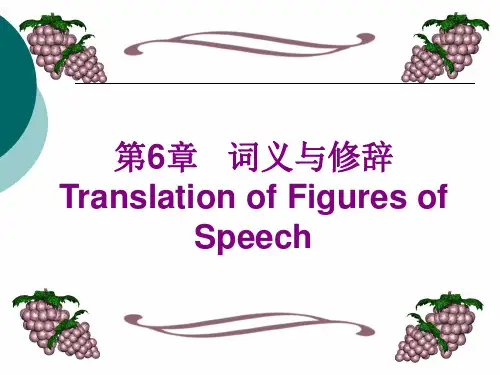
Figures of Speech1.Simile 明喻A simile is a very common figure of speech that uses the words “like” and “as” to compare two things that are not related by definition. For example, “he is as tall as a mountain,” does not mean he was actually 1,000 feet tall, it just means he was really tall.The Internet is like a window to the world—you can learn about everything online!2.Metaphor 暗喻A metaphor makes a comparison between two unlike things or ideas.Hope is a good breakfast, but it is a bad supper.Time is money.The world is a stage.She's a night owl.3.Alliteration 押头韵Alliteration is the repetition of the beginning sounds of neighboring words.She sells seashells.Walter wondered where Winnie was.Nick needed new notebooks.4.Euphemism 委婉Euphemism is a mild, indirect, or vague term that often substitutes a harsh, blunt, or offensive term.Letting you go instead of firing youPassed away instead of 'died.'Economical with the truth instead of liarHe is out visiting the necessary.5.Hyperbole 夸张Hyperbole uses exaggeration for emphasis or effect.I've told you to stop a thousand times.That must have cost a billion dollars.She's older than dirt.When she heard the bad news, a river of tears poured out.6.Oxymoron 矛盾修饰,逆喻An oxymoron is when you use two words together that have contradictory meanings. Some common examples include old news, little giant.For instance, imagine a woman who has a thirty-five year old son who still lives in her attic, playing video games and refusing to get a real job. An oxymoronic name for him could be used in this way:That’s my adult child. Poor thing still can’t get himself into the real adult world.An “adult child” literally does not make sense—you cannot have an adult who is also a child. This oxymoron, though, serves to describe an adult who refuses to act like an adult.7.Synecdoche 提喻Synecdoche occurs when a part is represented by the whole or, conversely, the whole is represented by the part.A boy has been admitted to the hospital. The nurse says, “He’s in good hands.”The boy is not literally being taken care of by two hands. Rather, he is being taken care of by an entire hospital system, including nurses, assistants, doctors, and many others.The Department of Education announced new plans for the education reform.In this example, the Department of Education as a whole cannot literally make such an announcement. Rather, an individual or set of individuals puts together the announcement.8.Personification 拟人Personification is a kind of metaphor in which you describe an inanimate object, abstract thing, or non-human animal in human terms.Sometimes the sun smiles, the wind whispers to the trees, and the shadows of the leaves dance in the wind.Science-fiction novels were his constant companions.9.Transferred epithet 移就It is a figure of speech where a modifier (usually an adjective) qualifies a noun other than the person or thing it is actually describing. In other words, the modifier or epithet is transferred from the noun it is meant to describe to another noun in the sentence.He crashed down on a protesting chair.He passed many an anxious hour in the train.He spoke to them in hesitant French.He opened the letter with nervous fingers.10.Antithesis 对照、对偶“Antithesis” literally means “opposite” – it is usually the opposite of a statement, concept, or idea. That’s one small step for a man – one giant leap for mankind.To err is human; to forgive, divine.Give me liberty, or give me death.11.Rhetorical question 修辞疑问句It is a question that is not asked in order to receive an answer from the audience or reader. It’s just posed to make a point.Can’t you tell me what has happened?“How many roads must a man walk down before you call him a man?”“Seven!”In this episode of The Simpsons, Mona Simpson is singing a famous song by Bob Dylan in which the first line is “How many roads must a man walk down before you call him a man?” Obviously it’s a rhetorical question because the singer doesn’t expect an answer, but Homer fails to understand this and hazards a guess.12.Pun 双关A pun is a joke that makes a play on words. A pun uses words that have several meanings or words that sound similar but have different meanings.Time flies like an arrow. Fruit flies like a banana.What is the difference between a conductor and a teacher? The conductor minds the train and a teacher trains the mind.I can’t remember which state my wife wanted to visit for our next vacation — it’s OK, Alaska. Read the joke out loud: “Alaska” sounds like “I’ll ask her.”13.Irony 反语Irony usually signals a difference between the appearance of things and reality.Looking at her son's messy room, Mom says, "Wow, you could win an award for cleanliness!"On the way to school, the school bus gets a flat tire and the bus driver says, "Excellent! This day couldn't start off any better!"14.Sarcasm 讽刺,挖苦Sarcasm is a form of verbal irony that mocks or expresses contempt. It’s really more a tone of voice than a rhetorical device. You’re saying the opposite of what you mean (verbal irony) and doing it in a particularly hostile tone.Saying "Oh, you're soooo clever!" with sarcasm means the target is really just a fool.15.Ridicule 嘲讽/奚落Bryan, ageing and paunchy, was assisted.Resolutely he strode to the stand, carrying a palm fan like a sword to repel his enemies.16.Metonymy 借喻,转喻Metonymy is when you substitute an attribute or something closely related to a thing for the name of the thing.Crown = monarch/monarchyOval Office = presidency/presidentLend a hand = helpThe pen is mightier than the sword.17.Anticlimax 渐降法It refers to a figure of speech in which statements gradually descend in order of importance. Unlike climax, anticlimax is the arrangement of a series of words, phrases, or clauses in order of decreasing importance.She is a great writer, a mother and a good humorist.He lost his family, his car and his cell phone.18.ClimaxHe sacrificed his business, his home, and his honor for political gain.Since concord was lost, friendship was lost; fidelity was lost; liberty was lost—all was lost.。
英语中常见的修辞手法1明喻(Simile) simile -简明英汉词典['sɪməli:]n. (使用like或as等词语的)明喻明喻是一种最简单、最常见的修辞方法,是以两种具有共同特征的事物或现象进行对比,表明本体和喻体的关系,两者都在对比中出现,其基本格式是“A像B”,常用的比喻词有as, like, as if, as though等。
如果使用得当可以把深奥的道理说得通俗、浅显、明白,使人可见可感可悟,把简单的事物表达的更为形象更为生动。
例如:Like climbing a mountain, we struggle up three feet and fall back two.(正如爬山,我们费力爬上三英尺,又掉下去两英尺。
)(大学英语第一册第三单元课文B)I see alsolocusts.(-传播毁灭。
) 2暗喻(the metaphor) metaphor['metəfə]n. 隐喻)(第二册第三单元课文A)Consider that the same cultural soil principles of 和人权准则。
)子,浪漫之花含苞待放。
)(3 转喻美国的公共汽车司机正在罢工(这里buses 喻指司机drivers)。
e好吧,”医生说,“我会尽力做到科学能做到的,但每当我的病人开始数自己葬礼上的马车时,药物的疗效就会减掉一半。
”)(大学英语第三册第六单元课文A)4夸张(the exaggeration) exaggeration -英汉双向大词典D.J.[ɪgˌzædʒəˈreɪʃən]- exaggerationn.1.夸张,夸大2.夸张的言语;夸张的手法- Exaggerationn. 夸张;夸大把事物的特征,有意地加以夸大或缩小,就叫夸张,即采用“言过其实”的说法,使事物的本质特征更好地呈现出来。
英语中夸张修辞格,应用极为频繁。
夸张的功能是突出事物的本质特征,因而给人强烈印象或警悟、启发。
1.Simile 明喻明喻是将具有共性的不同事物作对比.这种共性存在于人们的心里,而不是事物的自然属性.标志词常用like, as, seem, as if, as though, similar to, such as等.例如:1>.He was like a cock who thought the sun had risen to hear him crow.2>.I wandered lonely as a cloud.3>.Einstein only had a blanket on, as if he had just walked out of a fairy tale.2.Metaphor 隐喻,暗喻隐喻是简缩了的明喻,是将某一事物的名称用于另一事物,通过比较形成.例如:1>.Hope is a good breakfast, but it is a bad supper.2>.Some books are to be tasted, others swallowed, and some few to be chewed and digested.3.Metonymy 借喻,转喻借喻不直接说出所要说的事物,而使用另一个与之相关的事物名称.I.以容器代替内容,例如:1>.The kettle boils. 水开了.2>.The room sat silent. 全屋人安静地坐着.II.以资料.工具代替事物的名称,例如:Lend me your ears, please. 请听我说.III.以作者代替作品,例如:a complete Shakespeare 莎士比亚全集VI.以具体事物代替抽象概念,例如:I had the muscle, and they made money out of it. 我有力气,他们就用我的力气赚钱.4.Synecdoche 提喻提喻用部分代替全体,或用全体代替部分,或特殊代替一般.例如:1>.There are about 100 hands working in his factory.(部分代整体)他的厂里约有100名工人.2>.He is the Newton of this century.(特殊代一般)他是本世纪的牛顿.3>.The fox goes very well with your cap.(整体代部分)这狐皮围脖与你的帽子很相配.5.Synaesthesia 通感,联觉,移觉这种修辞法是以视.听.触.嗅.味等感觉直接描写事物.通感就是把不同感官的感觉沟通起来,借联想引起感觉转移,“以感觉写感觉”。
英语常用语义修辞格的翻译英、汉两种语言在语义方面都有大量的修辞方式。
这两种语言中经常运用形象性手段来加强语言效果,从而达到修辞目的。
而这种比喻性手段在两种语言中的表达方式上与形象性的比喻上,有的相同,有的不尽相同。
有的形象性用法能为一种语言的读者有所了解、接受,而对另一种语言的读者则显得陌生或不能接受。
因此,在翻译英语语义修辞格时,不仅要注意形式上的对应,更应注意符合汉语的表达习惯。
本文拟讨论英语常用的语义修辞格的翻译。
一、明喻(simile)在翻译英语的明喻时,一般采用直译法,将其译成汉语的明喻。
但由于英汉两个民族的历史发展、生活环境、风俗习惯各不相同,思维方式和美学观念也有所差异,有的英语明喻和汉语明喻的比喻形象不尽相同。
因此,有时也用意译法、变通法和注释法。
如:He was like a cock who thought the sun hadrisen for him to crow. 他这人就像一只骄傲的公鸡,以为太阳升起是为了它的啼叫。
( simile →明喻。
直译法)Tom was as sober as a judge. 他十分清醒。
(simile →非修辞格。
意译法)He is as cunning as a dead pig. 他像狐狸一样狡猾。
(simile →明喻。
但不是“像死猪一样狡猾”。
变通法)Falstaff : I am as poor as Job , my lord , but not sopatient . 福斯塔夫: 我是像约伯(注) 一样穷的,大人,可是却没有他那样的好耐性。
(注:约伯(Job)《圣经》中的人物, 以忍耐贫穷而著称的圣徒。
)(simile →明喻。
但译文意义不清楚,故加了注释。
注释法)二、隐喻(metaphor)英语隐喻的翻译,一般采用修辞格转换法或直译法,将其译成汉语的明喻或隐喻。
但由于英汉两种文化的差异,有时需要转换表达或修辞方式、或改变喻体以符合汉语的习惯。